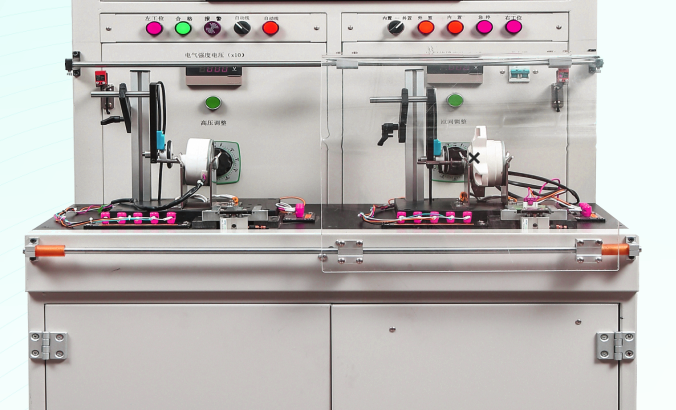What are the common control unit failures and solutions for brushless motor motor automatic no load tester?
The common control unit faults and solutions of brushless motor motor automatic no-load tester are as follows:
1、Controller overheating
Failure phenomenon: After the tester has been running for a period of time, the surface temperature of the controller is too high, and it may even trigger the overheating protection mechanism, resulting in test interruption.
Cause analysis
Failure of the cooling fan, such as fan blade damage, motor failure, etc., resulting in poor heat dissipation.
Poor ventilation at the controller installation location, with excessive clutter or equipment around it, affecting air circulation.
Excessive load, exceeding the rated power of the controller, resulting in prolonged high load operation of the controller.
Solution
Check the cooling fan, replace the damaged fan or repair the fan motor.
Re-adjust the installation position of the controller to ensure that there is enough space around it to maintain good ventilation.
Reasonable arrangement of test tasks to avoid prolonged overloaded operation of the controller, such as testing larger power motors, you can appropriately increase the test interval.

2、Abnormal control signal
Failure phenomenon: unstable motor operation, speed fluctuations, jitter or unable to run according to the set instructions, abnormal test data.
Cause analysis
Poor contact of the control line, such as loose plug, wire wear, etc., resulting in signal transmission interruption or interference.
Damage to the electronic components inside the controller, such as capacitor leakage, resistor deterioration, etc., affecting signal processing.
Errors or loopholes in the software program, resulting in incorrect control signal output.
Solution
Check the control line, make sure the plug is firmly connected, replace the worn wire, shield the line to reduce interference.
Overhaul the controller, replace the damaged electronic components, if you can not identify the specific faulty components, consider replacing the entire controller.
Update or repair the software program, re-download the correct program to the controller, if necessary, contact the equipment manufacturer for technical support.
3、Power failure
Failure phenomenon: the controller can not start normally, or in the operation of the process of a sudden power failure, resulting in the interruption of the test.
Cause analysis
Power adapter is damaged, unstable output voltage or no output.
The power cord is broken or short-circuited, resulting in the power supply can not be supplied normally.
The power circuit inside the controller is faulty, such as the voltage regulator chip is damaged and the filter capacitor is burst.
Solution
Replace the damaged power adapter to ensure that its output voltage and current meet the requirements of the controller.
Check the power cord and repair or replace the broken or short-circuited power cord.
Overhaul the power supply circuit inside the controller and replace the damaged power supply chips, capacitors and other components.
4, communication failure
Failure phenomenon: the tester can not communicate normally with the host computer or other devices, the data can not be transmitted or transmission error.
Cause analysis
Communication interface damage, such as USB interface, serial port and other loose, oxidation and other problems.
The communication protocol is set incorrectly, and the communication parameters between the tester and other devices do not match.
The communication line is disturbed, such as a strong electromagnetic field source nearby.
Solution
Check the communication interface, clean the oxidized layer on the interface surface, and repair or replace the damaged interface.
Reset the communication protocol to ensure that the communication parameters between the tester and other devices are consistent, such as baud rate, data bits, stop bits, etc.
Take shielding measures for communication lines, use shielded wires, and ground the shield reliably, away from strong electromagnetic field sources.
5, the controller is dead or stuck
Failure phenomenon: no response to the operator interface of the tester, the controller runs slowly, and the test operation cannot be carried out normally.
Cause analysis
Insufficient memory, the controller handles multiple tasks or stores a large amount of data at the same time, resulting in high memory occupation.
Hardware resource conflicts, such as multiple devices using the same interrupt request or I/O address.
After a long period of operation, the system accumulates a large number of temporary files or error messages, which affects system performance.
Solution
Optimize the test program, reduce unnecessary tasks and data storage, free up memory space, and increase the memory capacity of the controller if necessary.
Check the hardware settings and adjust the interrupt requests and I/O addresses of devices to avoid resource conflicts.
Regularly perform system cleanup and maintenance on the controller, delete temporary files, repair system errors, and consider restarting the controller to restore system performance.
※ If you still can't solve the problem by the above ways and means, please contact the technical specialists of Xinhui Electromechanical Equipment Co.







